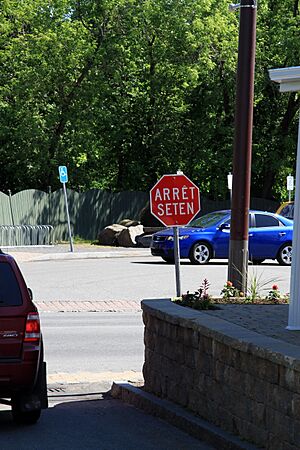Wyandot language facts for kids
Quick facts for kids Wyandot |
||||
|---|---|---|---|---|
| Waⁿdat | ||||
| Native to | Canada, United States | |||
| Region | northeastern Oklahoma, Quebec; recently near Sandwich, Ontario, and Wyandotte, Oklahoma | |||
| Extinct | There was an elderly speaker in 1972. | |||
| Language family | ||||
| Writing system | modified Latin | |||
|
||||
Wyandot (sometimes spelled Wandat) is a language from the Iroquoian family. It was traditionally spoken by the Wyandot or Wyandotte people. These people are descendants of the Tionontati tribe. Wyandot is very similar to the Wendat language, which is spoken by descendants of the Huron-Wendat Confederacy.
The last people to speak Wyandot lived mainly in Oklahoma, United States, and Quebec, Canada. For a long time, language experts thought Wyandot was just a different way of speaking Wendat.
Wyandot almost disappeared as a spoken language about 100 years ago. But now, people are working hard to bring it back! The Wyandotte Nation of Oklahoma teaches Wyandot language classes. These classes are for young students in kindergarten through fourth grade. They also have a special program for preschoolers called "Turtle-Tots."
In Quebec, the Huron-Wendat Nation offers classes for both adults and children. These classes teach the Wendat language at their village school in Wendake. The Wyandotte Nation of Oklahoma also has online lessons. This lets people learn the language on their own.
Contents
The Story of the Wyandot Language
Even though Wyandot is often thought of as a form of the Wendat (Huron) language, it actually became quite different. It changed so much that it is now seen as its own language. This change happened between the mid-1700s and the mid-1800s.
In the 1700s, a missionary named Pierre-Philippe Potier wrote down how the Petun people spoke Wendat in Canada. But by 1911–1912, when a researcher named Marius Barbeau studied Wyandot in Wyandotte, Oklahoma, it was different enough to be called a separate language.
Experts have found many differences between Wendat and Wyandot. These differences are in how sounds are made, how words are put together, and the words themselves. This shows that Wyandot is not just a modern version of Wendat.
The history of the Wyandot language is quite interesting. The ancestors of the Wyandot people were refugees from different Huronian tribes. They came together to form one new tribe. They had to leave their original home in Canada, near Georgian Bay. Then, they traveled south, first to Ohio, and later to Kansas and Oklahoma. Many people in this group were from the Petun tribe. Because of this, some experts think Wyandot was more influenced by Petun than by Wendat.
The work of Marius Barbeau was very important. A language expert named Craig Kopris used Barbeau's notes to rebuild the Wyandot language. He created a grammar (rules for the language) and a dictionary. This work is the most complete study of the Wyandot language. It shows how the language was spoken in Oklahoma just before it became "dormant," as tribal members now say.
How Wyandot Sounds Are Made
Wyandot has some unique sounds. For example, it is the only Iroquoian language with a clear difference between a "t" sound and a "d" sound. Most other Iroquoian languages only have one of these.
The "r" sound in Wyandot is like the "r" in English, not the rolled "r" you might hear in some other languages. Wyandot also has a special "zh" sound, like the "s" in "measure." This sound is not found in many other Iroquoian languages.
Words in Wyandot can have groups of consonants. These groups can be at the beginning, middle, or end of words.
How Wyandot is Written
Wyandot is written using the Latin alphabet, which is the same alphabet English uses. The way it's written today is based on how missionaries wrote it down in the 1600s.
In Wyandot, special marks are used to show certain sounds. For example, a small raised "n" (like ⁿd) can show a nasal sound before another consonant. Nasal vowels (vowels where air comes out of your nose) are shown with a special hook mark (like ę or ǫ). A glottal stop, which is a quick stop of air in your throat (like the sound in "uh-oh"), is written with a special symbol (ʔ). The "sh" sound is written as "š," and the "zh" sound is written as "ž."
Words You Can Learn
Here are a few words from the Wyandot language:
- Seten - Stop. You can see this word on stop signs in places like Wendake in Quebec.
- Skat - One
- Tindee - Two
- Shenk - Three
- Anduak - Four
- Weeish - Five
- Sandustee - Water
- Kanata - Village
- "änen'enh" - Mother
Wyandot and Wendat Today
The Wyandotte Nation, based in Wyandotte, Oklahoma, is working hard to bring the Wyandot language back. They want their people to learn it as a second language. This is part of a bigger effort to bring back their culture. Since 2005, Richard Zane Smith, a Wyandot person, has been teaching in Wyandotte schools. He gets help from the language expert Craig Kopris.
Work is also being done on the closely related Wendat language. In 2007, it was reported that John Steckley, an anthropologist, was the only non-native speaker of Wendat. However, several Wendat scholars now have master's degrees in the language. They are very active in helping their community in Quebec.
In Wendake, Quebec, the First Nations people are working to revive the Wendat language and culture. The language is now taught in classes for adults and in the village's primary school. Megan Lukaniec, a Wendat language expert, has been very important in creating lessons and materials for these programs.
You can even hear the Wyandot language in the television series Barkskins.


